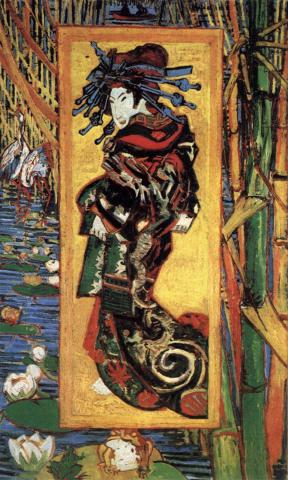-
Table of Contents
- 0. STORY PREFACE
- 1. EARLY LIFE
- 2. AN ARTIST IS BORN
- 3. STUDYING ART, FEELING PAIN
- 4. THE FIRST MASTERPIECE
- 5. THE PARIS YEARS
- 6. INFLUENCE of JAPANESE ART
- 7. EARLY LIFE in ARLES
- 8. THE BANDAGED EAR
- 9. VINCENT at SAINT-REMY
- 10. THE ATTACKS CONTINUE
- 11. PAINTING in AUVERS-sur-OISE
- 12. WORRIES and TURMOIL
- 13. VINCENT COMMITS SUICIDE
- 14. THE SADNESS WILL LAST FOREVER
While living in Paris, Vincent began to copy paintings created by Japanese artists. This image depicts one of those works. It is entitled “Oiran,” and it is based on a work by Kesai Eisen. Vincent worked on this oil-on-canvas, which measures 105 x 61 cm, between September and October of 1887. Today the original is maintained at the van Gogh Museum in Amsterdam.
Honing his skills in Paris, Vincent thought about how he could better work with color. He told Theo:
I want to use colors that compliment each other, that cause each other to shine brilliantly...
Just at that time, artists working in Paris had an opportunity to see art which made use of complimentary colors. Van Gogh greatly enjoyed - and was profoundly influenced by - Japanese woodblock prints. Still developing his own style - he would later say "colours that the Impressionists have brought into fashion are unstable" - Vincent was able to buy many prints for not much money. In an 1888 letter to Theo, he observed:
I envy the Japanese the extreme clarity of everything in their work. It is never dull and it never seems to be done in too much of a hurry. Their work is as simple as breathing, and they do a figure in a few sure strokes as if it were as easy as doing up your waistcoat. Oh, I still have to learn to do a figure in a few strokes. (Vincent to Theo, 24 September 1888.)
As we look at a sampling of Japanese prints, a few pointers will be helpful. Japanese artists had to be mindful of censors whose approval seals were placed on their work. The artist's signature, the publisher's seal, the title of the work and the series to which it belonged were all noted. This guide from the Brooklyn Museum explains that background.
Van Gogh especially liked prints by Ando Hiroshige. One of this artist's famous series (created between 1831-1834) was entitled Fifty-three Stations of the Tokaido. The Tokaido was the Eastern Sea Road which connected Toyko (then called Edo) with Kyoto (the old capital). The following woodblock prints are from that series:
Another popular series, created by Hiroshige, was One Hundred Famous Views of Edo (Tokyo). The woodblocks were made in an interesting manner, requiring the skills of several people. The results were often spectacular:
Van Gogh actually copied two of Hiroshige's prints (from his One Hundred Famous Views of Edo series) in 1887: Flowering Plum Tree (based on The Plum Orchard at Kameido) and Bridge in the Rain (based on Hiroshige's Evening Shower at Atake and the Great Bridge). Vincent also painted Oiran - also known as The Courtesan - after a work by Keisai-Eisen.
Before he left Paris, for a warmer climate in the south of France, Vincent had created 221 paintings. Taking leave of his brother, he was on the cusp of his most creative years.
-
Table of Contents
- 0. STORY PREFACE
- 1. EARLY LIFE
- 2. AN ARTIST IS BORN
- 3. STUDYING ART, FEELING PAIN
- 4. THE FIRST MASTERPIECE
- 5. THE PARIS YEARS
- 6. INFLUENCE of JAPANESE ART
- 7. EARLY LIFE in ARLES
- 8. THE BANDAGED EAR
- 9. VINCENT at SAINT-REMY
- 10. THE ATTACKS CONTINUE
- 11. PAINTING in AUVERS-sur-OISE
- 12. WORRIES and TURMOIL
- 13. VINCENT COMMITS SUICIDE
- 14. THE SADNESS WILL LAST FOREVER


 Back
Back
 Next Chapter
Next Chapter

 Back
Back
 Next Chapter
Next Chapter


